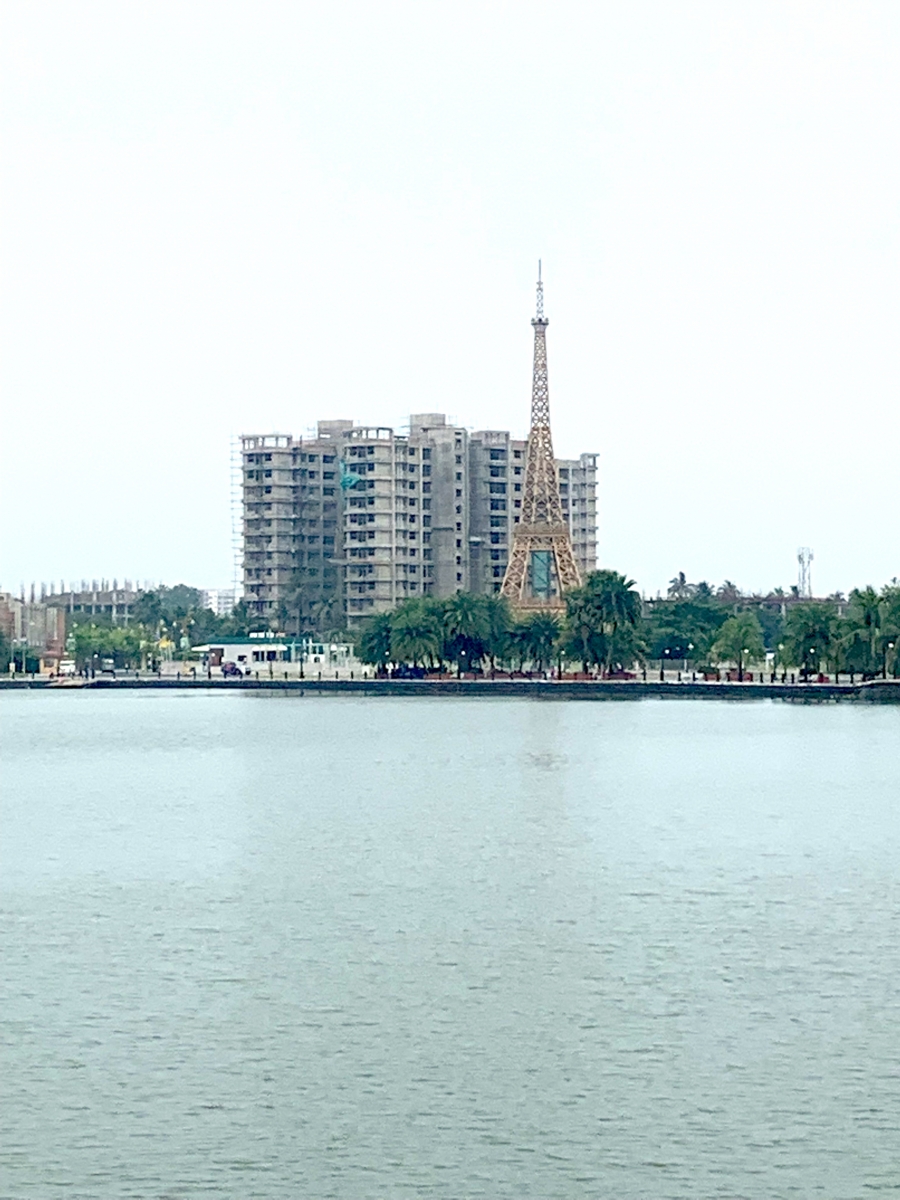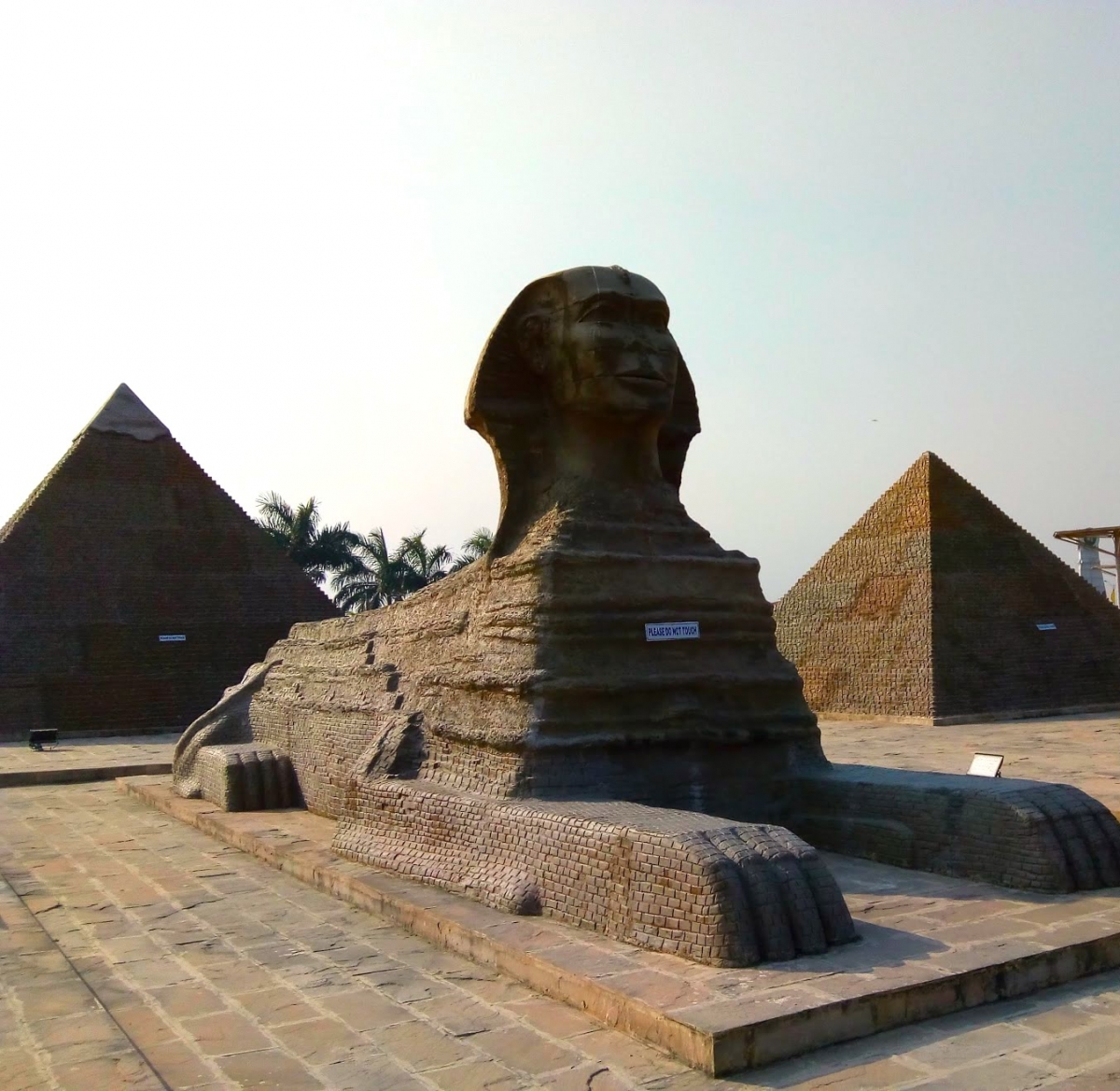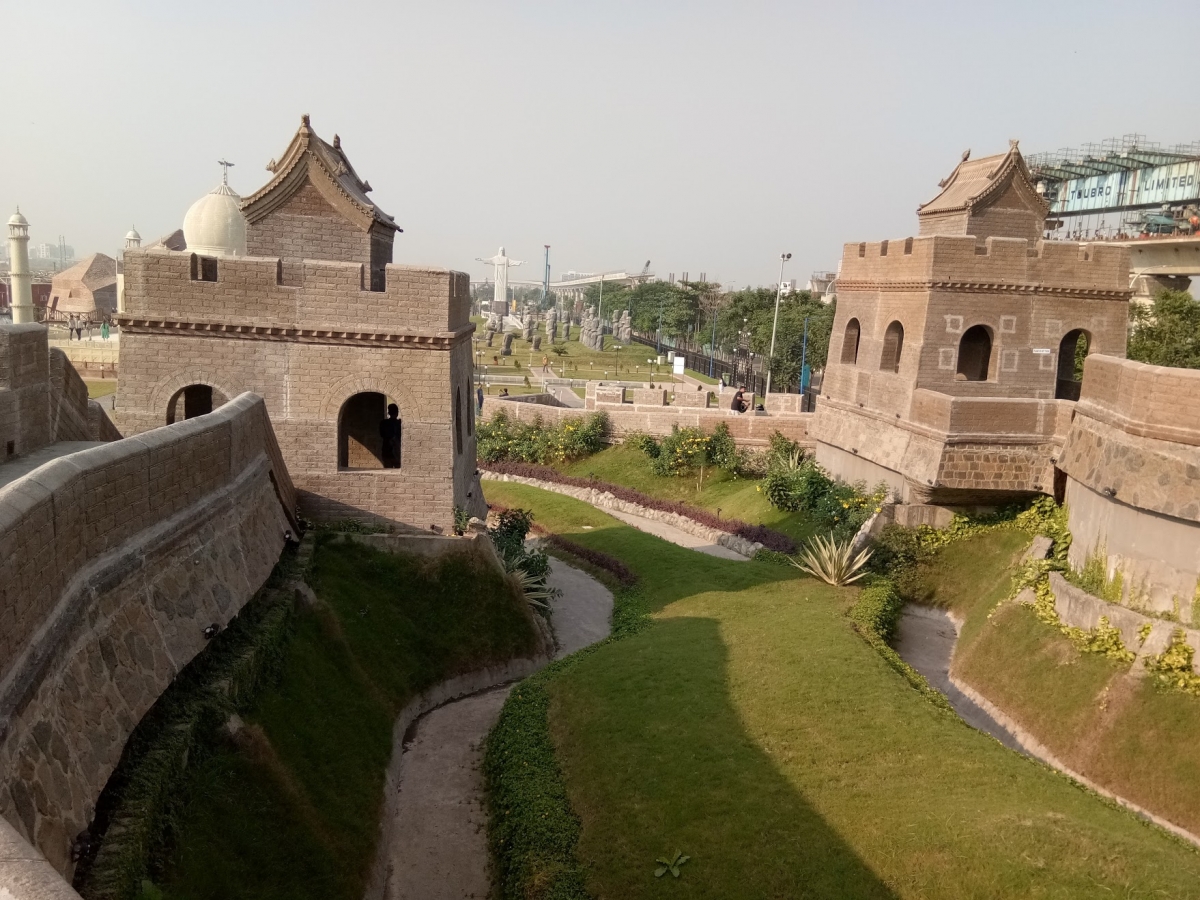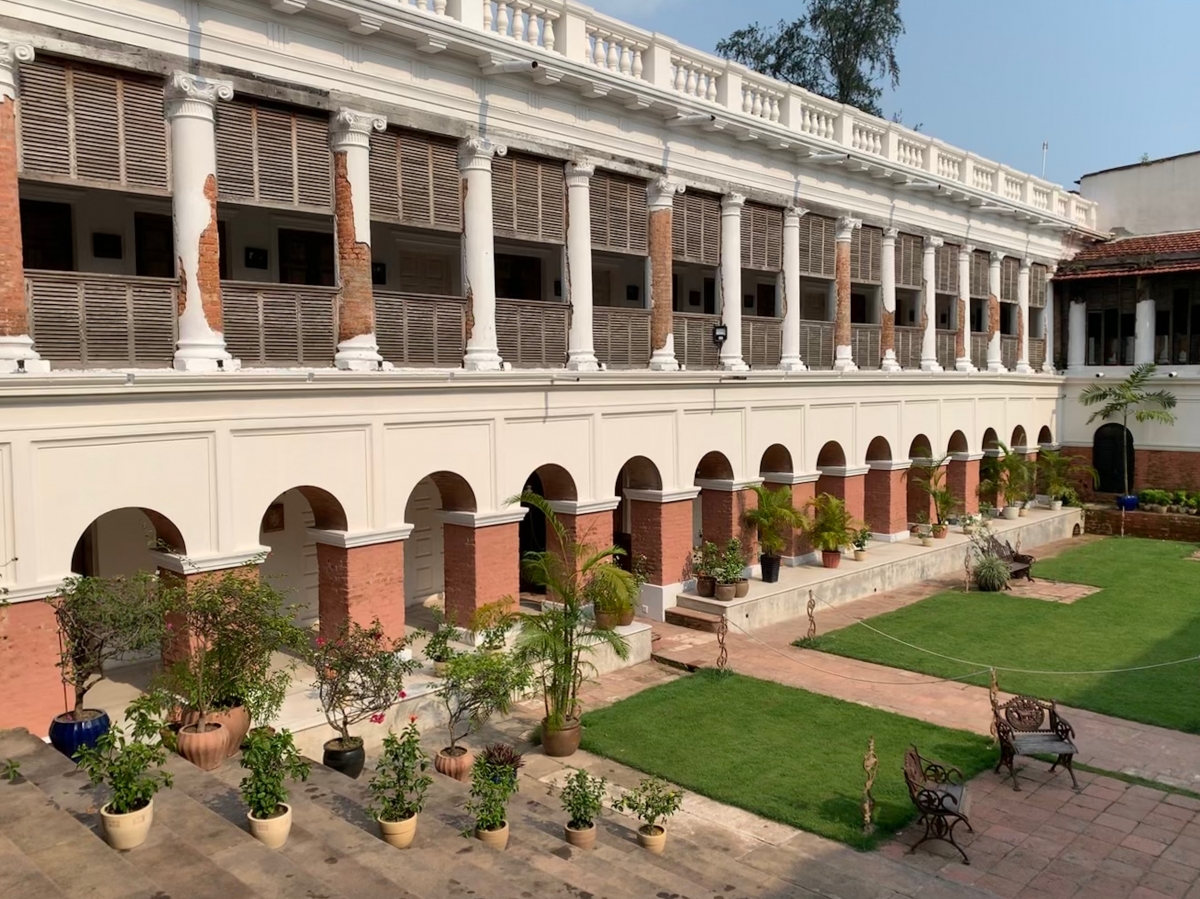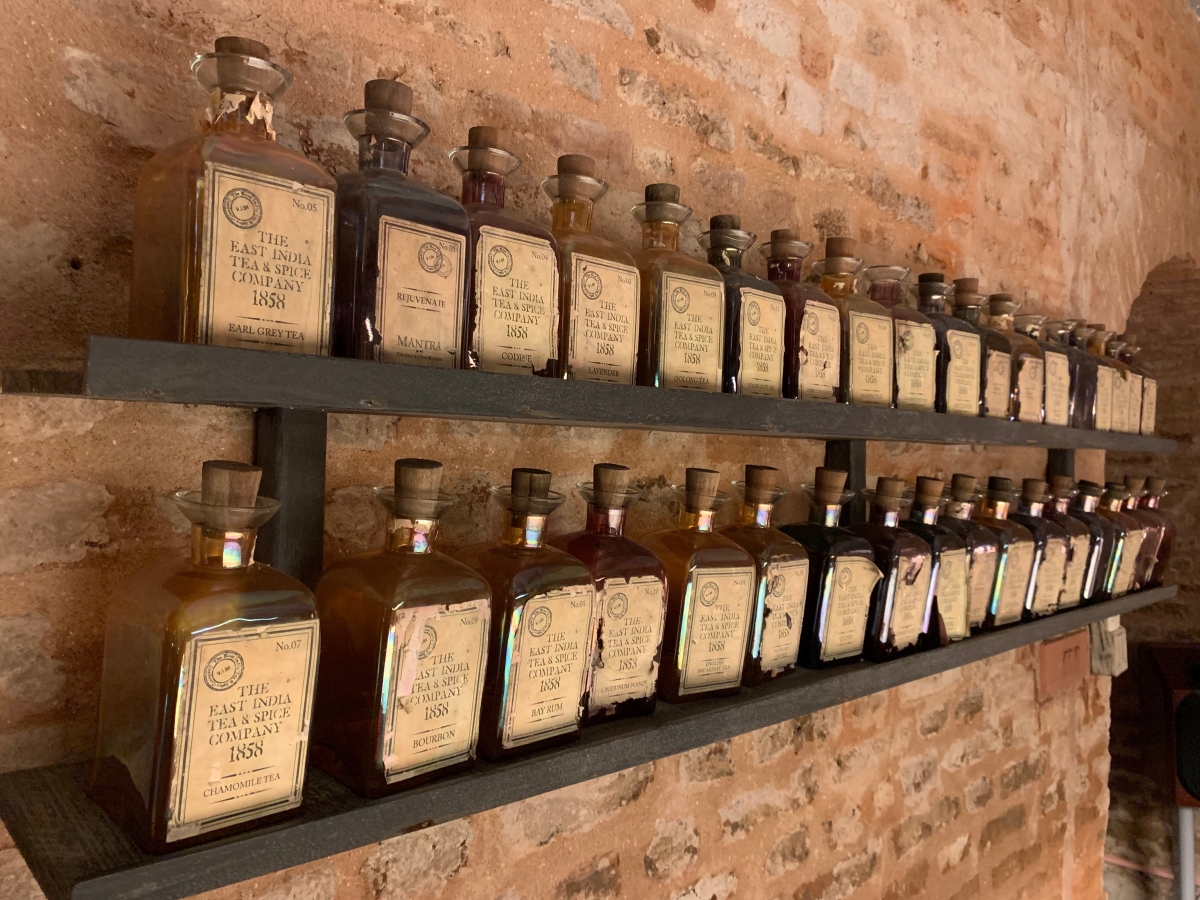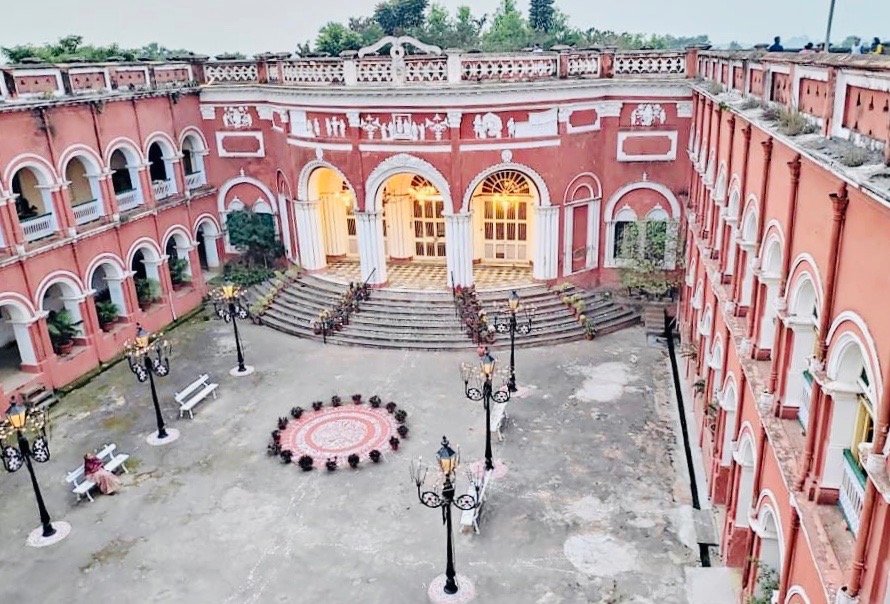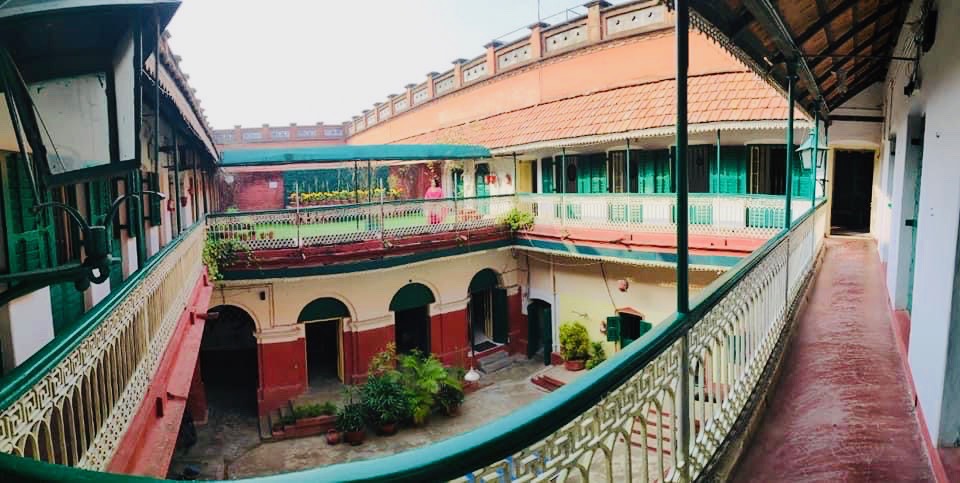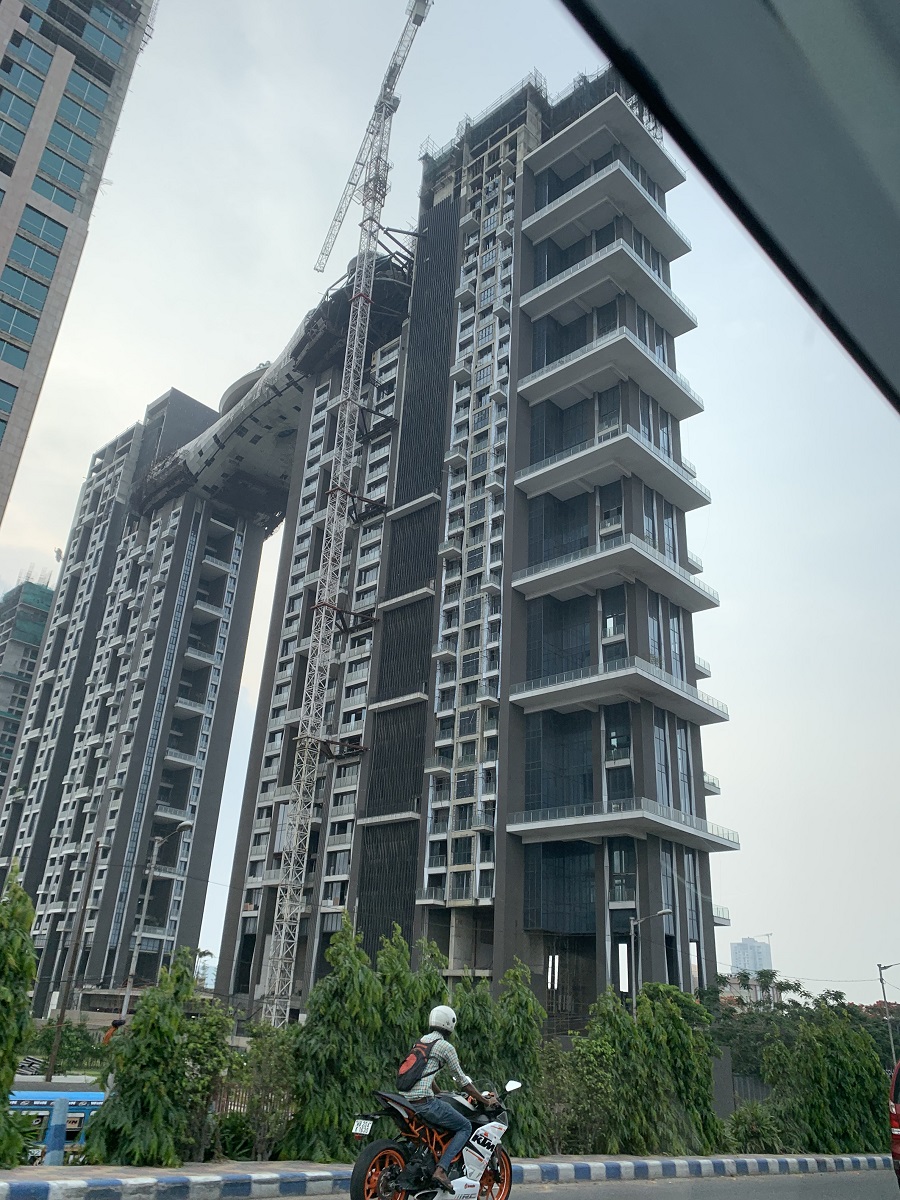
Image 1: New ongoing construction of high-rises in the city of Kolkata, pavements painted in blue and white, the colors representing the Trinamool Congress. Photo Credit: Tejdipto Bose
In 2011, Mamata Banerjee, the then newly elected Chief Minister of West Bengal [1] launched an ambitious project to realize her dream of “paribartan” or “transformation,” to “turn Kolkata into London” (Bose), “with the Hooghly river ‘as the theme on the lines of the Thames’” (Bose). The Left Front had ruled West Bengal for seven consecutive terms from 1977 to 2011, and Chief Minister Banerjee was using this moment of change in power to focus on themes of paribartan. Within the next few years, the Hooghly river banks were cleaned, sanitized, and paved; trident lampposts were installed along the ghats,[2] and in all other parts of the state; and official buildings, gate posts and railings were re-painted with the Trinamool Congress Party colors blue and white, eliminating any speck of red or symbolic representation of the erstwhile ruling Marxist government [see Image 1]. With the aim of setting apart herself, her policies and her party Trinamool Congress from the Communist Party of India (Marxist), Mamata Banerjee declared this to be her “dream project.” With a competitive zeal, she imagined her developmental project through a comparative lens – “In spite of a much smaller population than ours, Londoners could build such a beautiful city through proper planning. Even we can do so if specific plans are in place. Although our government do not have huge amounts of funds like that in London, I believe money will start pouring in from private players once the government takes a positive step towards beautifying the city” (Bose). This initiative to transform serves two purposes – 1. to dissociate from the earlier CPI(M) government, and 2. to challenge the image of Kolkata as a filthy, dangerous, decayed, disease-generating place, perpetrated by the British colonial officers, and also by nineteenth-century Western writers and novelists, and subsequently circulated in media, films and cultural representation. As Siddhartha Sen points out,
The first British governor of Bengal, Lord Robert Clive, called Kolkata “the most wicked place in the universe” (Robert Clive as cited in Thomas 1997: 3) as early as the 1770s. […] By the end of the nineteenth century, the English Nobel laureate poet and novelist Rudyard Kipling called Kolkata “The City of Dreadful Night” (Kipling [1899] 1907: 185) – a label that remained with the city for a long time in Western minds. […] He wrote that “Calcutta is above pretense” in hiding its stench. According to him, the air “is faint, it is sickly, and it is indescribable […] and there is no escape from it” (Kipling [1899]1907: 187). (Sen, 20)
Sen continues to list such descriptions of the city by Levi-Strauss (“[f]ilth, chaos, promiscuity, congestion, ruins, huts, mud, dirt, dung, urine, pus, humours, secretions and running sores”) (Sen, 20); V. S. Naipaul (“Calcutta, even to Indians, was a word of terror, conveying crowds, cholera, and corruption”) (Sen, 20); and Geoffrey Moorhouse (“nowhere is there beggary in the scale of Calcutta’s,”… “the worst that life has to offer”) (Sen, 20).
Such negative stereotypical images of the city led to justification for British colonial control, surveillance and imposition of power through architecture and urban planning. Citing Michel Foucault’s proposition “antiquity had been a civilization of spectacle” (Foucault, 270), Sen asserts that “[t]he spectacle of such architecture was aimed at inspiring multitudes of people by controlling them through spectacular events. In the confines of such architecture, the citizenry observed and experienced the power of the authoritarian state” (Sen, 24). Banerjee’s “dream project” to beautify the city in the model of London presents a paradox – while negating the notion of a “filthy” city perpetrated by colonialist and Orientalist discourses, she borrows a colonial model of surveillance and spectacle to assert control and impose state authority through architecture and urban planning. Moreover, her dream project included a revival of interest in nineteenth-century native and local architecture in the form of homestays, dissimulating a profit-generating capitalistic intention through a veneer of nostalgic return to “roots,” exemplified by support and government sponsoring of “folk” performances, discussed later in this essay.
Four years later, in 2015, a year before the next round of elections, a 135-foot replica of the London Big Ben was erected in the middle of a busy traffic intersection, as part of the Chief Minister’s vision to “turn Kolkata into London” (Kolkata Bureau) [see Image 2]. The changes implemented by the ruling government of West Bengal have been primarily cosmetic and touristic – by emulating the banks of Thames, and installing a replica of the Big Ben, Mamata Banerjee’s government has been orchestrating a simulacrum of what defines the city’s past colonizer.

Image 2: Replica of the Big Ben in the middle of a busy traffic intersection in Lake Town, Kolkata. Photo credit: Saurav Chakraborty
The initiative of reproducing, or rather superimposing, London in Kolkata is much more complex, not to mention ironic, in light of the city’s colonial history.[3] Mamata Banerjee, in declaring this paribartan, was not only resurrecting the colonial past, but also validating the iterative pattern of colonial power relations present in neo-liberal capitalistic pursuits of urbanization. Following a model similar to that of British colonialism of the past, the present West Bengal government has been performing tradition and modernity, both reinstating and troubling the binaries between the past and the present, the West and the East, and the urban and the rural. The past is imagined, “imagineered” (Werry), orchestrated and choreographed in a manner that benefits the present of globalization on the one hand, and the Bangaliyana (emphasizing Bengali-ness) culturalist, and parochial (as opposed to nationalist) obsession on the other.[4] This paper argues that such “strategic beautification” (Banerjee) of the urban space is a process of iterative colonialism enacted by the state at different stages of its history. Looking at contemporary Kolkata and the paribartan that the Trinamool government has proposed and executed between 2011 and the present, this paper examines how such initiatives contribute to further class and cultural segregation within the city, following the model of its colonial predecessors, enacting seemingly paradoxical strategies of simultaneous futuristic fantasy of the urban and nostalgic romanticization of the rural.
I will be focusing on two main sites of paribartan – the IT boom and the transforming skyline (projecting globalization and progress through replicas of mostly Western monuments and architectural structures, malls and highrises) in the city’s northeastern limits at Rajarhat, and the restoration of the “folk” in the form of festivals and Heritage Homestays, an initiative to uphold “tradition” while capitalizing on the tourism industry. This paper examines how this seeming paradox –the promotion of futuristic, high-tech urbanism alongside an equally imaginary and folkloric rural past – is ultimately united in its aim to serve the city’s neo-liberal pursuits of capitalistic development.
The Colonial Past: Looking Back at Colonial Calcutta
The English East India Company arrived around the late seventeenth century (Bhattacharya),[5] when the Company gradually came to occupy large parts of the land that now make up the city of Kolkata (Dutta and Desai). The occupied land covering three villages – Sutanuti, Kalikata, and Gobindapur (Banerjee, Gupta and Mukherjee) – eventually came to be called Kolkata, the anglicized version of which is Calcutta. The town planning and structuring of the city by the British town planners was largely based on their administrative priorities and convenience, with little to no regard paid to the interests of local residents. In 1757, the British shifted Fort William (which was named after the then reigning British monarch William III and housed the British soldiers) from Kalikata (where it was established in 1698) to further south in Gobindapur village (Banerjee, 20-22). This reconstruction of Fort William, from 1758 to 1773, in the western part of Gobindapur resulted in large-scale displacement of villagers. The rich villagers were given cash compensation to move further upward in the Sutanuti area, where new settlements were formed along the Chitpur Road and later came to be known as the Black Town. The poorer villagers were moved eastward, where the East India Company was building roads and clearing jungles, and therefore needed labor for its administrative and entrepreneurial ventures. The poor villagers were resettled in slums that were named after English owners of the plots of land that were rented out – such as Duncan’s Bustee and Colvin’s Bustee. The Company was designing and choreographing a demographic pattern based on class, privilege, race, economic and cultural power relations, segregating the Black Town from the White, the rich from the poor, and the English from the native. As Sumanta Banerjee puts it:
These English and European residents cut up slices of Chourungi and Kalinga villages into roads and streets. They christened them with their own names, and according to their own style (for example, Camac Street, Kyd Street, Park Street, Theatre Road, Elysium Row, and so forth). They constituted what came to be designated as the White Town in the historical narrative of colonial Calcutta. (Banerjee, 23)
Unsurprisingly, these slums in the Gobindapur area, which were separated and segregated from their wealthy neighbors inhabiting the White Town, had to be cleared through the nineteenth and twentieth centuries to make roads, thereby displacing the local, laboring residents yet again.
However, this imperial choreography of encroaching on lands, displacing and resettling populations, and “creating strictly bordered arterial thoroughfares” (Banerjee, 28) was constantly being subverted, interrupted and sabotaged by locals who built narrow lanes and by-lanes called golis in Bengali. They also named these golis after their local celebrated small-business owners such as washerwomen and tailors, interrupting municipal authorities’ urban planning by reclaiming ownership of their local spaces.
Even though the colonial histories are traced through the city’s road-systems and arrangement of demographics, the traces of contra-modern resistance are found in the performance space outside of the hegemonic surveillance – in serpentine golis, in slums and makeshift dwellings that trouble the neatly organized state choreography of control, dominance and exploitation.
Post-Partition Calcutta saw the rise of the Left Front and the Communist Party of India (Marxist), owing primarily to the Bengali intelligentsia’s alignment with Leftist politics. What started as a party for the “poor” and the marginalized, including Muslims, low-caste and tribal communities, and poor peasantry, soon became a party associated with hegemonic control and “a pattern of governance marked by lethargy and ineptitude” (Bose, Al-Jazeera.com). As Sumantra Bose explains, “The well-organised CPI(M) cadre network continued to deliver electoral success in the absence of a strong grassroots competitor. Over the past two decades this cadre network resorted increasingly to strong-arm and malafide methods to win elections, including intimidation of ordinary people as well as outright fraud (‘rigging’ in the local parlance)” (Bose, Al-Jazeera.com). The final nail in the coffin was the 2006-2007 Singur controversy, when the Trinamool (quite literally meaning “grassroots”) Congress filled in the vacuum created by the LF (through corruption, negligence and ineptitude), by their impassioned protests against the CPI(M) forcefully acquiring peasant land for establishing automotive plants in pursuit of its developmental ambitions.[6]
The “Glocal” Present: Designing paribartan through orchestration of the “local” and the “global”

Image 3: The replica of the Wall Street Bull and the Fearless Girl in New Town, Kolkata. Photo credit: Tejdipto Bose
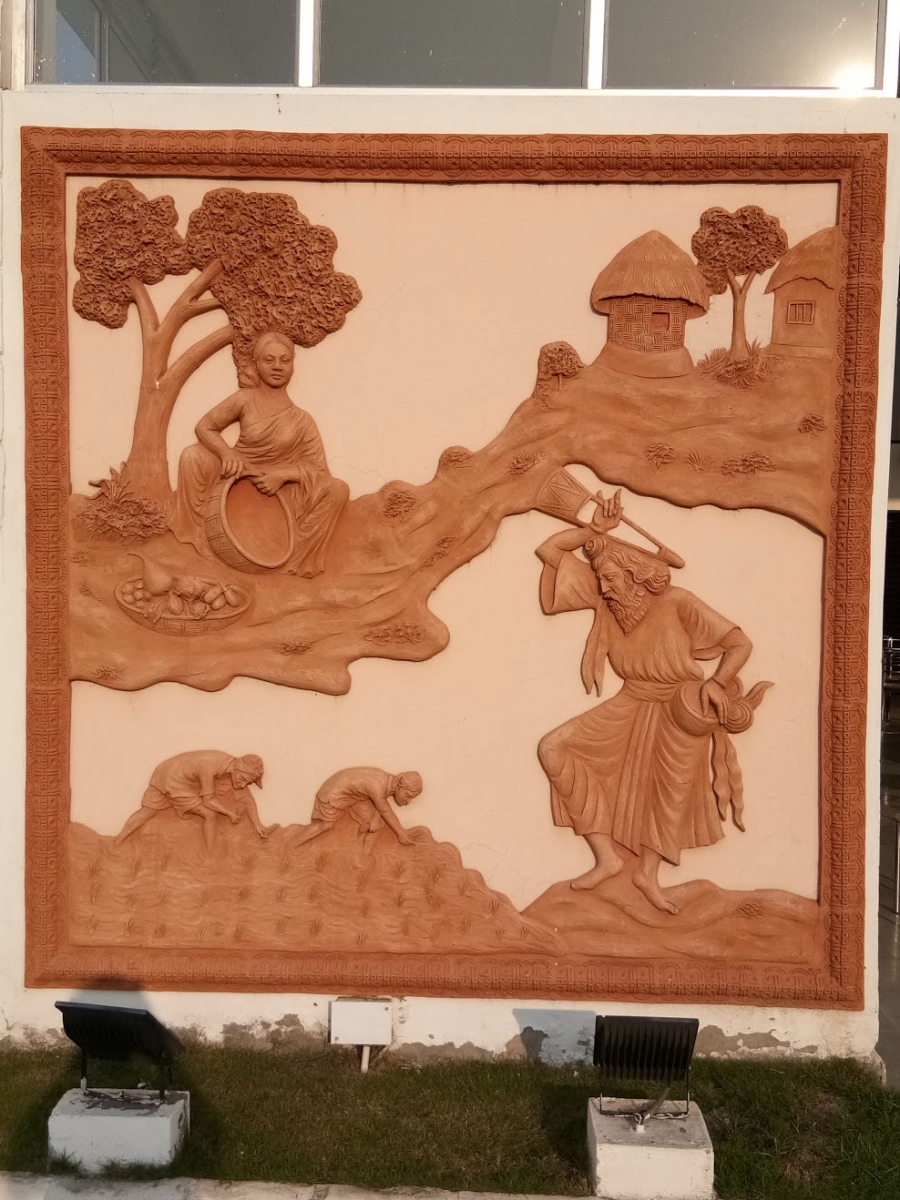
Image 4: A “folk” mural in New Town representing rural life. Photo credit: Tejdipto Bose
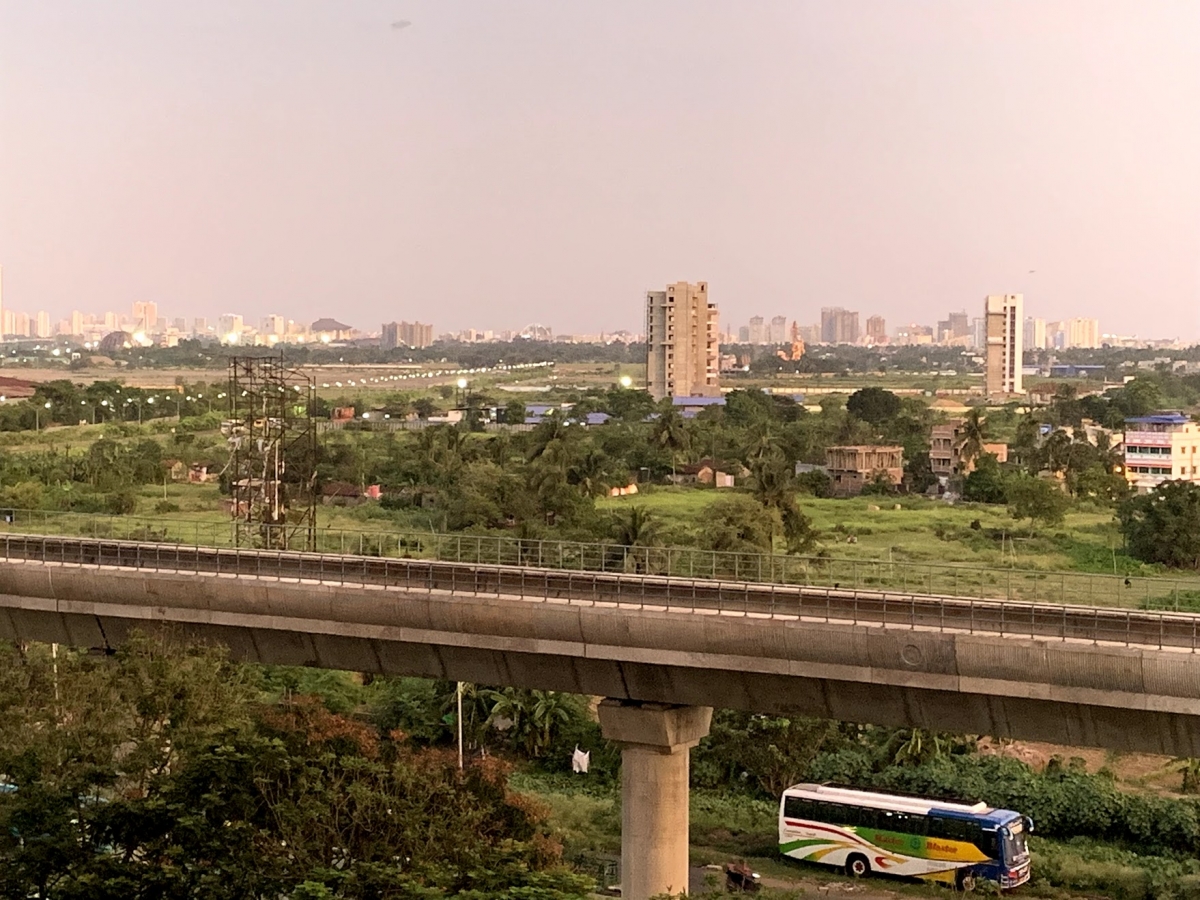
Image 5: View of the Rajarhat skyline. Photo credit: Tejdipto Bose
Since coming to power in 2011, Mamata Banerjee’s paribartan goals have been double-pronged with simultaneous parallel initiatives of indigenization and localization on the one hand, and Westernization, or emulation of London, the city’s past colonizer, on the other hand. Besides urban planning and design that include erecting a “Big Ben,” engaging in developments of a “New Town” with simulacra of monuments from all over the world, of trident lamp posts along the Ganges, to emulate the River Thames bank, there have been governmental orders to have loudspeakers playing Rabindrasangeet or Rabindranath Tagore’s [7] Bengali songs at major traffic intersections in the city, evoking a kind of parochial Bengali pride, and a significant initiative by the state to reinvigorate the “folk” in the city and its suburbs [see Images 3, 4, 5]. This juxtaposition of scales, the melding of the global and the local, exemplifies what John Meyer and many others have termed “glocalization,” which, according to Meyer, occurs when “Nations celebrate their unique heritages while moving into standard models” (Meyer, 245).
Image 6: The Biswa Bangla Gate in New Town, Kolkata. Photo credit: Tejdipto Bose
In 2017, the Housing Infrastructure Development Corporation set up the Biswa Bangla Gate, or the Kolkata Gate, at New Town on Biswa Bangla Sarani [see Image 6]. The name itself is symbolic of this duality of localization and globalization at the same time – “Biswa” meaning the world, and Bangla denoting the state of West Bengal. The message of Trinamool Congress to address the local and the global, seemingly ambivalent, is clearly cohesive and in correspondence with its neo-liberal profit-making model. As one drives along the newly constructed Eco Park in Rajarhat, one can even spot an Eiffel Tower, a Taj Mahal and pyramids, all within the same complex, once again enacting a kind of “colonial mimicry” (Bhabha, 126), while also exhibiting its slippages, by displaying counterfeit monuments and “wonders of the world” in random spatial arrangements [see Images 7, 8, 9]. Almost like Las Vegas, Kolkata has begun to resemble what Michael Sorkin has identified as a theme park, a “a city of simulations” (Sorkin, xiv) or a “recombinant city” (Sorkin, xiii), where “anything seems to go with anything – hierarchies are both reinforced and concealed, at once fixed and despatialized” (Sorkin, xiii). While Sorkin recognized a kind of Disneyfication of such a city, he also points towards the extreme surveillance and control as another characteristic, a form of surveillance not unfamiliar to a colonial framework of control and domination. As Sumanta Banerjee states:
New Town harks back to the early days of colonial policy of spatial division of Calcutta according to the needs of the then dominant power. Like the White Town of the past, New Town of today reproduces the same pattern of institutionalizing (through spatial policies) the territorial monopoly of the dominant interests, denial of rights to the subordinate groups in the making of such policies, and the systematic deprivation of these underprivileged groups. It is a neo-colonial reproduction of the past model of urbanization by an indigenous ruling elite. (Banerjee, 160-61)
Image 7: Replica of the Eiffel Tower at Eco Park in New Town, Kolkata.
Image 8: Replica of the Sphinx and the pyramids at Eco Park in New Town, Kolkata. Photo credit: Tejdipto Bose
Image 9: Replica of the Great Wall of China; the Taj Mahal; and Christ the Redeemer statue at Eco Park in New Town, Kolkata. Photo credit: Tejdipto Bose
Not only are the underprivileged groups of people used for labor to build such infrastructural splendor that the metropolis boasts of, some of these subaltern groups become part of the revenue-generating machine of the neo-liberal economy through the emergence of tourism and the heritage economy, while being excluded from these recreational spaces because of unaffordable ticket prices. The contemporary urban- planning desires replicate a colonial design, the paribartan, therefore, fueled not just by random superimposition of colonial architecture and structures, but also by an iteration of the colonial power structures.
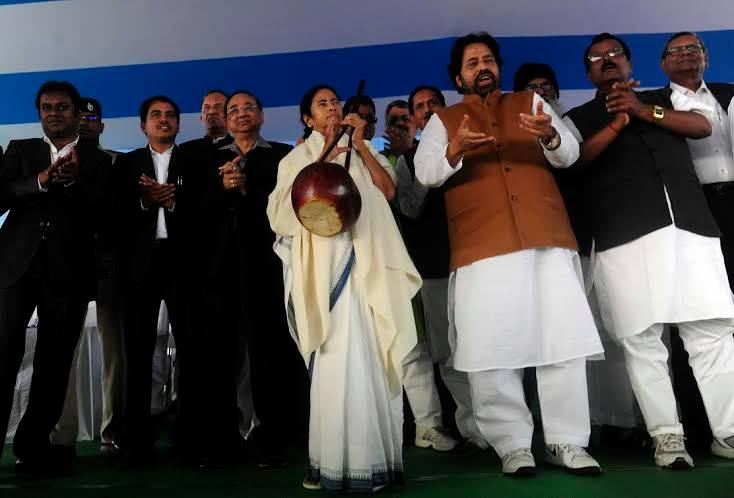
Image 10: Chief Minister Mamata Banerjee holding an ektara. Photo from the official Facebook page of Chief Minister Mamata Banerjee
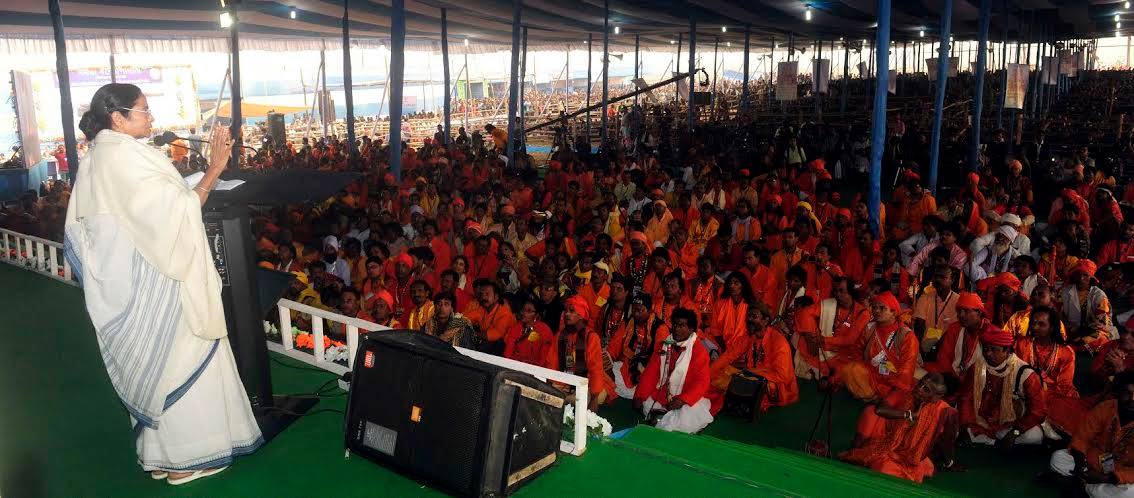
Image 11: Chief Minister Mamata Banerjee addressing the Bauls at a meeting. Photo from the official Facebook page of Chief Minister Mamata Banerjee
On the other hand, the branding of Bengal as a repository of rich “folk” traditions has been a robust and parallel initiative by the Trinamool government. The January 2016 Facebook page of Chief Minister Mamata Banerjee features photographs of her attending a long-established Baul [8] festival [see Images 10, 11]. Wearing her characteristic white cotton sari with a blue border, she appears along with other ministers and suited up government officials, holding an ektara (a traditional, one-stringed musical instrument used by performing Bauls), while posing in front of the camera. There are also photographs of her addressing a crowd of saffron-clad Bauls; another one where she greets a Baul on stage, while government officials and ministers on stage look on. On her official Facebook page, such photographs are accompanied by a note emphasizing the significance of “folk arts” (Banerjee, Facebook.com). The Facebook “status” tab further adds the initiatives of the government in not only preserving the folk arts, but also furthering economic prosperity by creating more jobs.
For preservation, research and further development of this rich folk art, we have decided to set up ‘Joydev Baul Academy’ in Kenduli, the foundation stone of which was laid today.
I visited ‘Radha Binod Temple,’ commonly known as Joydev Mandir in Kenduli and advised district administration to draw up plans to spruce up the area befitting to heritage status.
District administration in association with Tourism Department has built a beautiful eco-friendly tourist complex near Bolpur. I have named it ‘Rangabitan.’ (Banerjee, Facebook.com)
Image 12: The Bawali Rajbari. Photo credit: Tejdipto Bose
Image 13: A room inside the Bawali Rajbari. Photo credit: Tejdipto Bose
Image 14: The dining room for guests at the Bawali Rajbari. Photo credit: Tejdipto Bose
Image 15: The Itachuna Rajbari. Photo credit: Tarun Kumar Bose
Image 16: A corridor and the courtyard inside the Itachuna Rajbari. Photo credit: Tarun Kumar Bose
The state choreographs this curious intersection and juxtaposition of the “indigenous folk” and the “Western urban” for the city of Kolkata, both with ultimately an intention to cater to the tourism industry. In addition, there has been an increase in the number of “folk” festivals, as well as heritage tourism in the form of rajbaris or a resurrection of the history of feudal Bengal, reimagining the “traditional” and the “ethnic.” Some of these houses have been renovated and reconstructed with the idea of recreating the aesthetics of the wealthy landowners’ houses from the colonial period. Not only are these houses open to tourists for viewing, some of these, such as the Bawali Rajbari, the Itachuna Rajbari and the Lal Bari, also operate as what is termed “Heritage Homestays” [see Images 12, 13, 14, 15, 16]. Each of these has websites, describing the history of the houses and their subsequent renovation, with room rates ranging from Rs. 2,500 ($34.11) to Rs. 7,000 ($95.51) [9] per night. While the slogan for Bawali Rajbari seems to be “inspired heritage” (TheRajbari.com), Itachuna Rajbari’s is “a taste of royalty” (ItachunaRajbari.com). Additionally, each page on the Itachuna Rajbari website exhibits a line from a guest’s feedback: “We were breathing history, smelling the past and the British Bengal…with an absolutely new spice of enriching Bengal” (ItachunaRajbari.com). This idea of “tradition” and “heritage” associated with a form of cultural nostalgia, negating labor, exploitation and colonial history is problematic on several levels. Besides inattention to the disparities and segregationist histories of the past, the heritage industry also ignores the labor disparities of the present, reenacting the classist segregation, ensuring a certain demographic of tourists through their considerably high tariffs. As Bhabha summarizes,
[I]n signifying the present, something comes to be repeated, relocated and translated in the name of tradition, in the guise of a pastness that is not necessarily a faithful sign of historical memory but a strategy of representing authority in terms of the artifice of the archaic. That iteration negates our sense of the origins of the struggle (Bhabha, 52).
While the state reconstructs and resurrects an “artifice of the archaic” on the one hand in the guise of “tradition,” the changing scenes of the present globalizing condition requires it to exhibit signs of progress through a mimicry of London as well as subscribing to imaginaries of a progressive, technologized, neoliberal state [see Image 17].
Image 17: The view of New Town from the Biswa Bangla Gate. Photo credit: Tejdipto Bose
In conclusion, Banerjee’s paribartan goals in Kolkata exhibit overarching trends of capitalizing the colonial history in the desire for a neoliberal profit-oriented capitalistic future. In replicating colonial architectures, reviving “folk” art forms, and imagining a globalized urban space, the State redesigns a “recombinant” (Sorkin) Kolkata, along with its embedded hierarchies, class structures, erasures and exclusions, therefore enacting what Mark-Anthony Falzon terms a “politics of exclusion” (145). And simultaneously, within the system of state-produced performance of “tradition” and “modernity,” slippages are produced through overt and covert subversion of state designs and desires of neatly organized streets and thoroughfares, just like the emergence of serpentine golis in British-ruled Calcutta. In his 2010-2011 fieldwork journal, Sumanta Banerjee describes the ways in which the under-city bypasses and subverts the state designs of neo-liberal urbanization utilizing some of the infrastructural facilities of the state itself.
At midnight, as I walk down the paths of neon-lit glittering Park Street – Theatre Road, where the bars and restaurants are still alive, I follow my nose through the old familiar territory and soon sniff my way into one of the back lanes. The grocery stores and tea shops that operate during the day have already put up their shutters. Dim street lights spread a lemon haze. I enter the cardboard city – another urban complex made up of paper and plastic, scraps and rags. It is now time for another Kolkata to come alive. (Banerjee, 69)
These interstitial spaces of temporary dwellings outside of the IT centers and shopping malls become contested spaces. The domestic helps, rickshaw pullers, vegetable vendors, hawkers and presswallahs who stay in these temporary arrangements on footpaths, “on the margins of metropolitan desire” (Bhabha, 31), serving the upper- and middle-class residents of the high-rises and towers in New Town and Rajarhat, bridge the class gaps, in a certain way bringing the slum dwellers, city dwelling urban classes and the middle classes together at least spatially, if not culturally, undoing the state’s neat designs.
Sukanya Chakrabarti, Ph.D.
Sukanya Chakrabarti (she/her/hers) is an artist-scholar and Assistant Professor, Theatre Studies at San Francisco State University. Her performance practice, scholarship and teaching lie in the intersection of postcolonial studies, globalization studies, and urban studies, with a focus on South Asian and transcultural theatre and performance studies, experimental devised performances and community-based performance-making.
Works Cited
Banerjee, Himadri, Nilanjana Gupta, Sipra Mukherjee, editors. Calcutta mosaic: Essays and interviews on the minority communities of Calcutta. New Delhi, Anthem Press, 2009.
Banerjee, Mamata. “Folk arts like ‘Baul’ occupy a very important place in Bengal’s culture and heritage,” January 18, 2016, www.facebook.com/MamataBanerjeeOfficial/posts/1016203875113620 (Accessed on January 31, 2021).
Banerjee, Sumanta. Memoirs of Roads: Calcutta from Colonial Urbanization to Global Modernization. New Delhi, Oxford University Press, 2016.
Bhabha, Homi. “Of Mimicry and Man: The Ambivalence of Colonial Discourse.” October, vol. 28, MIT Press, 1984, pp. 125–33, doi:10.2307/778467.
Bhattacharya, Sudip. Unseen Enemy: The English, Disease, and Medicine in Colonial Bengal, 1617 – 1847. England, Cambridge Scholars Publishing, 2014.
Bose, Raktima. “Mamata wants to turn Kolkata into London.” The Hindu, August 3, 2011, www.thehindu.com/news/national/mamata-wants-to-turn-kolkata-into-london/article2317137.ece (Accessed on July 26, 2021).
Bose, Sumantra. “The end of an era in West Bengal and India: The three-decade rule of the communist party in West Bengal has tasted the bitterness of defeat for the first time.” Al-Jazeera, May 18, 2011, www.aljazeera.com/opinions/2011/5/18/the-end-of-an-era-in-west-bengal-and-india (Accessed on July 28, 2021).
Chandra, Nirmal Kumar. “Tata Motors in Singur: A Step Towards Industrialisation or Pauperisation?” Economic and Political Weekly, vol. 43, no. 50, 2008, pp. 36–51. JSTOR, www.jstor.org/stable/40278289.
Dutta, K. and A. Desai. Calcutta: A Cultural History. Northampton, Massachusetts, Interlink Books, 2008.
Falzon, Mark-Anthony. “Paragons of Lifestyle: Gated Communities and the Politics of Space in Bombay.” City & society, vol. 16, no. 2, 2004, pp. 145–167.
Foucault, Michel. “Panopticism.” in (editor), Readings in the Philosophy of Technology, edited by David M. Kaplan, Maryland, Rowman & Littlefield Publishers, 2009.
“Itachuna Rajbari: A Taste of Royalty.” Itachuna Rajbari, www.itachunarajbari.com/tariff/#tariffpanel (Accessed on September 20, 2021).
Kolkata Bureau. “Big Ben” big trouble in Kolkata.” The Hindu, November 12, 2015, www.thehindu.com/news/cities/kolkata/big-ben-big-trouble-in-kolkata/article7867031.ece (Accessed on January 31, 2021).
Meyer, John. “Globalization: Sources and Effects on National States and Societies.” International Sociology, Vol. 15, No. 2, SAGE Publications, June 2000, pp. 233–48, doi:10.1177/0268580900015002006.
Sen, Siddhartha. Colonizing, Decolonizing, and Globalizing Kolkata: from a Colonial to a Post-Marxist City. Amsterdam, Amsterdam University Press, 2017.
Sorkin, Michael. Variations on a Theme Park: The New American City and the End of Public Space. New York, Hill and Wang, 1992.
“The Rajbari Bawali: Inspired Heritage.” Rajbari Bawali, www.therajbari.com (Accessed on September 20, 2021).
Werry, Margaret. The Tourist State: Performing Leisure, Liberalism, and Race in New Zealand. Minneapolis, University of Minnesota Press, 2011.
Notes
[1] Also the leader of the Trinamool Party, Mamata Banerjee was supported by the British High Commission, the Tourism Department, and the Kolkata Municipal Corporation for this “paribartan” initiative.
[2] The river banks are referred to as ghats. Most commonly, ghats are paved flight of stairs leading to the river.
[3] I should also point towards the irony inherent in the ambitions of the contemporary government, considering its history and the manner in which it came to power. The Trinamool Congress, headed by Ms. Mamata Banerjee, came to power exhibiting its alignment with subaltern groups of farmers and agricultural land owners in what eventually came to be known as the Singur controversy. In 2006, the then Chief Minister of West Bengal, Buddhadeb Bhattacharya, had acquired 997 acres of land in Singur, a small village in Birbhum district of West Bengal, to lease out to Tata Motors, which had proposed to build car factories with the aim of producing the world’s cheapest cars priced at Rs. 100,000 (equivalent to present-day $ 1375.72). This created conflict between the government and the agricultural landowners, who claimed that the deals would be exploitative for the latter. Their protests were strongly backed by Trinamool Congress, then the opposition party, opposing the draconian British colonial era law of 1894, The Land Acquisition Act (updated only as recently as 2013), which allowed the ruling government to appropriate private property and transfer it to a private third party for redevelopment purposes. Only a couple of years after this Singur-Tata Nano controversy, in 2011, Mamata Banerjee was sworn in as the Chief Minister of West Bengal, with the vision of paribartan, transforming Kolkata to (an imagined) London. Read: Nirmal Kumar Chandra, “Tata Motors in Singur: A Step Towards Industrialisation or Pauperisation?” Economic and Political Weekly, vol. 43, no. 50, 2008, pp. 36–51. JSTOR, www.jstor.org/stable/40278289.
[4] Such strategies of change from Banerjee can also be interpreted as a reaction against the central government controlled by Narendra Modi and his party Bharata Janata Party (BJP), whose focus has been to reinstate a Hindu nation, as opposed to a Constitutionally defined secular one. One of the ways of resistance by Banerjee has been to isolate Bengal politics and Bengali culture, almost as starkly different from and contrasted with a pan-Indian monolithic Hindutva-leaning culture that the Modi government has been orchestrating. Banerjee has, therefore, been leaning towards an intensification of Bengali-ness, as well as an opening up of borders, and outlook, to embrace a “global” perspective, once more contrasted with Modi’s inward-looking, “Make-in-India” approach. This has led to both an intense localization and a simultaneous global vision, which has, in turn, manifested in an arbitrary curation of monumental exhibits, and sponsoring of local folk arts.
[5] In 1687, Job Charnock, an Administrator with the British East India Company, signed a peace treaty with the Mughal rulers to settle in Uluberia (in present-day Howrah), after several thwarted attempts to occupy Eastern parts of India. Having found it uninhabitable, he soon moved back to Sutanuti in 1687. Later, in 1690, the three villages of Sutanuti, Kalikata, and Gobindapur were merged by the British, which is believed to be the birth of the city of Calcutta (present-day Kolkata). See Sudip Bhattacharya, Unseen Enemy: the English, Disease, and Medicine in Colonial Bengal, 1617 - 1847 Newcastle upon Tyne, (England: Cambridge Scholars Publishing, 2014).
[6] See Note 3.
[7] A Bengali poet, playwright, novelist, musician and a polymath who made substantial contributions to Bengali and English literature in the late nineteenth and early twentieth century, Tagore was also one of the major exponents of social changes during the period of Bengal Renaissance, and played a significant role in the history of the anti-imperial Indian national movement.
[8] Bauls are traditionally wandering mystics from Bengal who perform songs and dances as a means to reach the divine. They are a syncretic heterogenous group of marginalized performers whose lineages can be traced back to religious practices such as Vaishnavism, Shaivism, Sufism and Sahajiya Buddhism.
[9] These numbers are in accordance with exchange rates on April 1, 2021.


